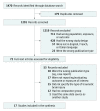Association of Concussion With the Risk of Suicide: A Systematic Review and Meta-analysis
- PMID: 30419085
- PMCID: PMC6439954
- DOI: 10.1001/jamaneurol.2018.3487
Association of Concussion With the Risk of Suicide: A Systematic Review and Meta-analysis
Abstract
Importance: Concussion is the most common form of traumatic brain injury (TBI). While most patients fully recover within 1 week of injury, a subset of patients might be at a higher risk of suicide.
Objective: To assess the risk of suicide after concussion.
Data sources: We performed a systematic search of Medline (PubMed), Embase, PsycINFO, and Published International Literature on Traumatic Stress (PILOTS) from 1963 to May 1, 2017. We also searched Google Scholar and conference proceedings and contacted experts in the field to seek additional studies.
Study selection: Studies that quantified the risk of suicide, suicide attempt, or suicidal ideation after a concussion and/or mild TBI were included. Studies that included children and adults, including military and nonmilitary personnel, were included. Two authors independently reviewed all titles and abstracts to determine study eligibility.
Data extraction and synthesis: Study characteristics were extracted independently by 2 trained investigators. Study quality was assessed using the Newcastle-Ottawa Scale. Study data were pooled using random-effects meta-analysis.
Main outcomes and measures: The primary exposure was concussion and/or mild TBI, and the primary outcome was suicide. Secondary outcomes were suicide attempt and suicidal ideation.
Results: Data were extracted from 10 cohort studies (n = 713 706 individuals diagnosed and 6 236 010 individuals not diagnosed with concussion and/or mild TBI), 5 cross-sectional studies (n = 4420 individuals diagnosed and 11 275 individuals not diagnosed with concussion and/or mild TBI), and 2 case-control studies (n = 446 individuals diagnosed and 8267 individuals not diagnosed with concussion and/or mild TBI). Experiencing concussion and/or mild TBI was associated with a 2-fold higher risk of suicide (relative risk, 2.03 [95% CI, 1.47-2.80]; I2 = 96%; P < .001). In 2 studies that provided estimates with a median follow-up of approximately 4 years, 1664 of 333 118 individuals (0.50%) and 750 of 126 114 individuals (0.59%) diagnosed with concussion and/or mild TBI died by suicide. Concussion was also associated with a higher risk of suicide attempt and suicide ideation. The heightened risk of suicide outcomes after concussion was evident in studies with and without military personnel.
Conclusions and relevance: Experiencing concussion and/or mild TBI was associated with a higher risk of suicide. Future studies are needed to identify and develop strategies to decrease this risk.
Conflict of interest statement
Figures


Comment in
-
On the Link Between Concussions and Suicide.JAMA Neurol. 2019 Feb 1;76(2):140-141. doi: 10.1001/jamaneurol.2018.3445. JAMA Neurol. 2019. PMID: 30419107 No abstract available.
-
Gehirnerschütterung verdoppelt Suizidrisiko.MMW Fortschr Med. 2019 Apr;161(6):35. doi: 10.1007/s15006-019-0352-8. MMW Fortschr Med. 2019. PMID: 30937775 Review. German. No abstract available.
-
Absolute Risk Estimates of the Association Between Concussion and Suicide-Reply.JAMA Neurol. 2019 Jul 1;76(7):871-872. doi: 10.1001/jamaneurol.2019.1452. JAMA Neurol. 2019. PMID: 31180471 No abstract available.
-
Absolute Risk Estimates of the Association Between Concussion and Suicide.JAMA Neurol. 2019 Jul 1;76(7):870-871. doi: 10.1001/jamaneurol.2019.1449. JAMA Neurol. 2019. PMID: 31180472 No abstract available.
References
Publication types
MeSH terms
LinkOut - more resources
Full Text Sources
Medical

